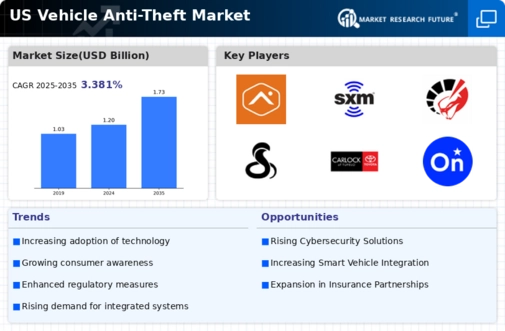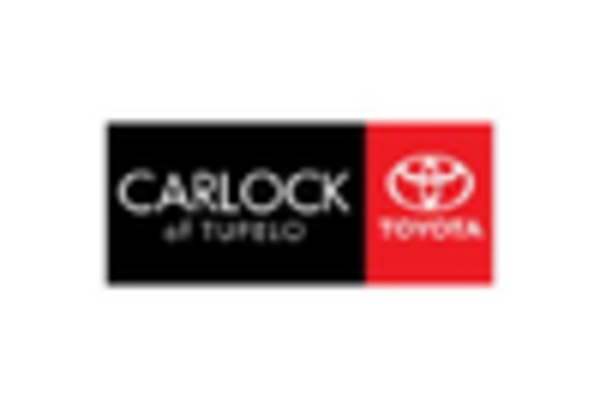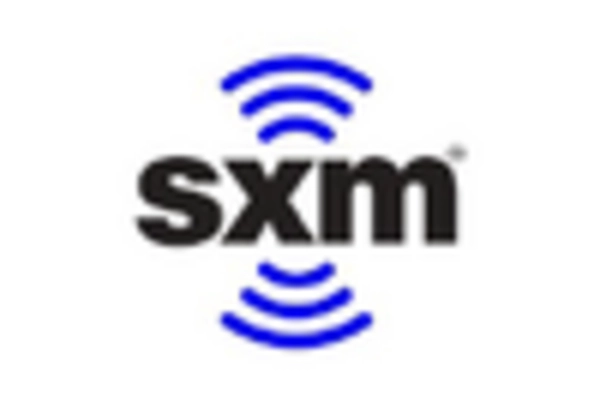Rising Vehicle Theft Rates
Growth is occurring due to the alarming rise in vehicle theft rates across the United States. According to the FBI, motor vehicle thefts increased by approximately 10% in 2023 compared to the previous year. This surge in theft incidents has heightened consumer concern, prompting individuals to seek advanced anti-theft solutions. As a result, manufacturers are innovating and introducing more sophisticated security systems, including GPS tracking and immobilizers. The increasing prevalence of organized crime targeting vehicles further exacerbates this issue, leading to a greater demand for effective anti-theft measures. Consequently, the vehicle anti-theft market is likely to expand as consumers prioritize the protection of their assets.
Technological Integration in Vehicles
The integration of advanced technology in vehicles is significantly influencing the vehicle anti-theft market. Modern vehicles are increasingly equipped with smart features, including keyless entry systems and connected car technologies. These advancements, while enhancing convenience, also present new vulnerabilities that can be exploited by thieves. As a response, the vehicle anti-theft market is evolving to incorporate cutting-edge technologies such as biometric systems and mobile app controls. The market for these innovative solutions is projected to grow, with estimates suggesting a potential increase of 15% in the next five years. This trend indicates that consumers are willing to invest in high-tech anti-theft systems to safeguard their vehicles.
Legislative Support for Vehicle Security
Legislative measures aimed at enhancing vehicle security are playing a crucial role in shaping the vehicle anti-theft market. Various states have enacted laws mandating the installation of anti-theft devices in certain vehicle categories, particularly for high-risk models. These regulations not only promote consumer safety but also stimulate demand for anti-theft products. The vehicle anti-theft market is likely to benefit from such legislative support, as compliance with these laws encourages manufacturers to innovate and improve their offerings. Furthermore, public awareness campaigns led by government agencies are expected to increase consumer interest in anti-theft solutions, thereby fostering market growth.
Insurance Incentives for Anti-Theft Devices
Insurance companies in the United States are increasingly offering incentives for vehicle owners to install anti-theft devices, thereby driving growth in the vehicle anti-theft market. Many insurers provide discounts on premiums for vehicles equipped with certified anti-theft systems, which can lead to savings of up to 20% on insurance costs. This financial motivation encourages consumers to invest in anti-theft solutions, contributing to the overall market expansion. As awareness of these benefits spreads, more vehicle owners are likely to consider installing advanced security systems, further propelling the vehicle anti-theft market. The collaboration between insurers and manufacturers may also lead to the development of more effective anti-theft technologies.
Consumer Demand for Enhanced Security Features
The growing consumer demand for enhanced security features in vehicles is a significant driver of the vehicle anti-theft market. As vehicle owners become more aware of the risks associated with theft, they are increasingly seeking comprehensive security solutions. This trend is reflected in Market Research Future indicating that approximately 60% of consumers prioritize anti-theft features when purchasing a vehicle. Manufacturers are responding by integrating advanced security technologies, such as remote monitoring and real-time alerts, into their products. This shift in consumer preferences is likely to propel the vehicle anti-theft market forward, as individuals invest in systems that provide peace of mind and protect their investments.

















Leave a Comment